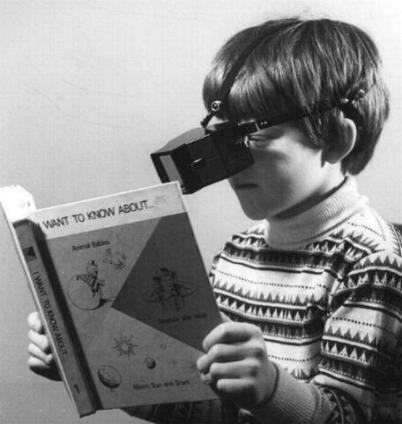
The Original Myopter
Chapter 9
THE MYOPTER: DEVELOPMENT

The Original Myopter
The prototype. Since it was obvious that there was no way that any form of eyeglasses could do the job, the idea of a totally new viewing device began to take shape in my mind. I knew that there were binocular microscopes on the market that had an optical system that enabled the user to use both eyes without convergence or stereopsis. I therefore obtained the necessary optical parts and mounted them in a small box that could be attached to the front of an ordinary pair of eyeglasses. This was the prototype of the Myopter viewer except that it had no provision for inserting lenses as the current model does.
Although the current model uses mirrors, this early prototype was made with prisms. Light rays reflect off of the internal surfaces of these prisms as if they were mirrors. Refer to figure 1 for a cutaway view of the instrument.
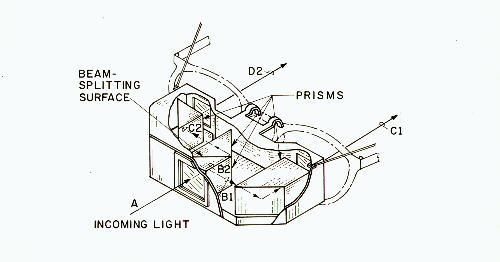
Fig. 1
Light coming from the viewed object (A) enters the single opening at the front and is split by a beam splitter into two identical parts (B1 and B2). The beam splitter consists of two prisms cemented together. One of the prisms has a special coating applied before the other prism is cemented to it. This coating only reflects half of the light that strikes its surface. Thus, half of the incoming light is reflected ninety degrees at the beam splitter and is again reflected ninety degrees by a prism into the left eye (C1). The other half of the light passes through the beam splitter and is reflected by two other prisms into the right eye (C2 and D2). The two beams emerging from the instrument are parallel and the axes of the eyes must also be parallel. Otherwise, a double image might be seen. This eliminates both convergence and stereopsis. Each eye sees an identical picture. The accommodation is eliminated by putting the proper lenses in the eyeglass frame.
With this instrument, I felt that it would be possible to completely fool the eyes into feeling that they were looking into the distance even though they were being used for reading. Reading could thus be turned from a harmful activity into a beneficial one.
The day came when all the parts were assembled and the device was ready for its first trial. What would it be like to read without accommodation, convergence and stereopsis? Would such a device prove to be practical? Would my eyes feel all right? I put the device on my head and held a book in front of me, fully prepared for failure. As I had feared, it didn't work. I saw two images of the book. After a little reflection and experimentation, I realized what was happening. Since I knew the book was close to me I was automatically converging, thus causing the double image. I found that it was easy to overcome this by first holding the book at arm's length and relaxing my convergence so that each eye looked straight ahead. Then the book could be brought closer while maintaining the single image.
The instrument worked beautifully! I could read for hours without the slightest discomfort. The only drawback was that the field of view was quite small, but it was large enough to read a book. I couldn't wear the device at the office, but I used it as much as possible for reading in the evening. By using the device in this way for several months, I was able once again to get an improvement in my vision. I had hoped that I would be able to eliminate all of my nearsightedness, but this proved to be impossible. As I learned more about myopia in succeeding years, I realized that some overelongation of my eyes must have occurred and this, or course, cannot be reversed with the Myopter viewer or by any other known means.
After using the instrument for an hour or so, I noticed that a mild bloodshot condition sometimes developed around the iris of my eyes. This went away after I put the instrument aside. I interpreted this condition in the following way: because I was holding the book beyond the far point, where it was a little blurred, the ciliary muscle was making an active effort to relax. This negative accommodation called for an increased supply of blood to the ciliary muscle (located in the area surrounding the iris). It was this increased supply of blood that caused the slight redness, and it was an indication that the eye was really working hard at relaxation. I could see a similar situation in weight lifters whose skin becomes redder in the area of muscles that have just had a hard workout.
I was convinced that any child who used such a device for reading would not develop myopia. The next step was to prove that it would work on others before going into production of a marketable version. Over the next few years, I contacted a large number of eye doctors to try to interest them in using the prototype on their patients. No one was interested. I wrote to all of the major manufacturers of optical instruments to see if they would develop and market a commercial version. They weren't interested.
The first test. I finally managed to come in contact with Robert Bedrossian, an ophthalmologist and researcher in Vancouver, Washington, who agreed to try the instrument on one of his patients. In spite of the limitations of this crudely made prototype, it reduced the myopia of a young girl from -.75 D to -.50 D in three months' time.
Designing the current model. During the years I had wasted trying to interest others in helping to put the instrument on the market, I had succeeded in setting aside enough money to enable me to go ahead on my own. I decided that if the job was ever going to get done, I would have to do it myself.
I therefore designed a commercially acceptable version of the instrument and in 1972 marketed it myself. In November, 1972 I applied for a United States patent on the instrument and the method of using it. I also obtained trademark protection for the word "Myopter."
The instrument was introduced to the optometric profession in the United States in a paper that I presented at the 1973 Annual Meeting of the American Academy of Optometry in San Francisco (See the Appendix for the complete paper). The instrument was introduced to optometrists of other countries in a paper I presented at the 1973 Congress of the European Society of Optometry in Copenhagen, Denmark.1
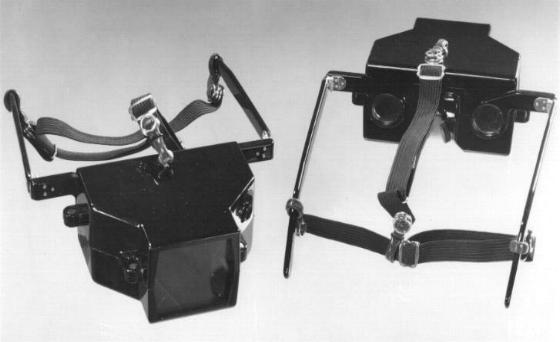
The Myopter Front and Back
Refer to the photograph for the external appearance of the instrument. It is worn in place of glasses and is held in position by adjustable straps, one behind the head and one passing over the top of the head. Like eyeglasses, the unit rests on the nose and has an earpiece, or temple) on each side. Soft pads are provided where the unit touches the nose. The strap behind the head should be rather loose. If it is pulled too tight, the instrument will press too hard against the nose. In the current version, the temples and straps have been eliminated and a Velcro strap holds the device on the head.
The instrument consists of an upper and lower half made of plastic, which can be separated by removing four bolts. Figure 2 shows a cutaway view of the instrument as viewed from above.
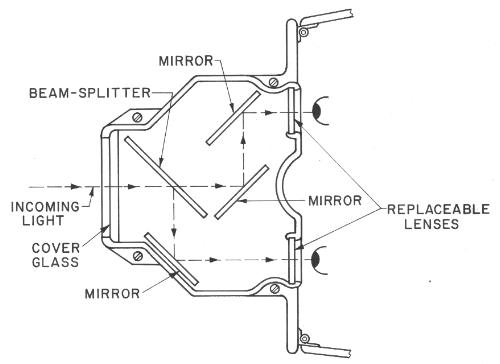
Fig. 2
Mirrors are used instead of prisms, but the path of light through the instrument is the same as in the prototype. The beam splitter consists of a single piece of glass with a semireflective coating on its front surface, which reflects half of the incoming light and transmits the other half.
The replaceable twenty-millimeter-diameter lenses fit into slots in the Myopter housing, and can be changed by taking the housing apart.
An assortment of the most common lenses (from -3 D to +3 D in 0.5 D steps) are available for use with the instrument, but any kind of lenses can be used by selecting eyeglass lenses of the proper thickness and grinding them down to a twenty-millimeter diameter.
There is no magnification or minification designed into the instrument, so the objects viewed are seen in their natural size except for any size change caused by the lenses. Depth perception is still possible because of the relative size of the various objects in the field of view, the shadows that they cast, etc. However, the depth perception that we normally get from stereopsis is eliminated.
Since the amount of light entering the instrument is split into two parts, with only one-half going to each eye, it might be assumed that this is like reading in poor light, and that it would therefore have the undesired effect of contributing to the myopia development. This is not the case. Poor lighting only contributes to the development of myopia when the eyes are accommodating. Since the accommodation is relaxed when using the instrument, the lower light level is in no way harmful. If anything, it is beneficial. It may result in a stronger effort by the ciliary muscle to relax, since the pupil will be larger. Actually, the reduction in the light level when using the instrument is hardly noticeable.
When using the instrument for the first time, it may be a little difficult to relax the external muscles of the eyes so that the visual axes are parallel. Although no accommodation or convergence is required, the patient is mentally aware that the viewed object is nearby, and force of habit creates a tendency to converge, causing double vision. This can be remedied if the viewed object is moved farther away until only a single image is seen. The object should then be brought closer - while the single image is maintained - until it is back at the normal reading distance.
Pupillary distance. To avoid excess complication, weight, and cost, I did not design the instrument to be adjustable for the full range of pupillary distances. Pupillary distance, or P.D., is the distance between the pupils of the eyes. The viewer was designed with a nominal P.D. of 64 millimeters, but can be used by most people without problems.
If the instrument is worn by someone whose P.D. is smaller or larger than 64 mm, it will not make the eyes converge or alter the effect that the instrument has on the eyes. It only means that the two images of the front of the Myopter that are seen by the eyes will not be superimposed on each other but will be moved slightly to the side. Figure 3 illustrates what would be seen by a person whose P.D. is smaller than sixty-four millimeters. In other words, the shaded areas are seen only by one eye. This has no practical significance, and is usually not noticed by the user.
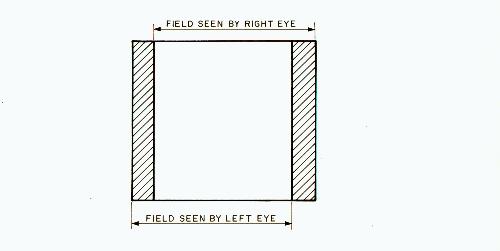
Fig. 3
Field of view. Figure 3 shows how the field of view is limited to approximately twenty degrees, both horizontally and vertically. This is sufficient to read a book without needing to turn the head. It also illustrates how more of the book is seen if it is held at normal reading distance than if it is held closer to the eyes.
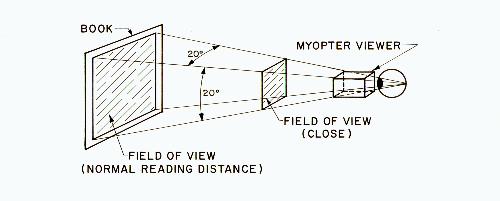
Fig. 4
There is an advantage to having this rather restricted field of view that is not readily apparent. By holding the book farther away, more of it can be seen. As the book is brought closer, the increasingly restricted field of view will eventually make it necessary to turn the head back and forth slightly when reading the lines of print. There is therefore a built-in inducement to hold the book farther away, and this is exactly the habit we want the user to develop and carry over to those times when reading is done without the instrument. One problem with reading glasses or bifocals is that they do not have this built-in inducement to refrain from holding the book too close.
When the instrument is used, the distance from the eyes to the book is not important. As long as the proper lenses are used, both accommodation and convergence will be eliminated at any distance.
Stereopsis. Some people have questioned the advisability of completely eliminating stereopsis. They seem to feel that we need stereopsis and that it is unnatural to eliminate it. There is no logic to this position since there is no stereoscopic effect when we look into the distance. It is actually fortunate that the elimination of convergence by means of a beam splitter also eliminates stereopsis. It would make no sense to eliminate accommodation and convergence while attempting to retain stereopsis, since such an arrangement would be completely unnatural.
Some years ago, a number of three-dimensional films were made. To view these films, special glasses were used so that each eye saw a different image on the screen. Under these conditions, the eyes were neither accommodating nor converging, but the three-dimensional effect was retained to give a more life-like appearance to the screen and make it appear closer. In a discussion of these films, one author points out the results of upsetting this natural balance:2
The commercial failure of three-dimensional films has taught some noteworthy lessons. Refractionists should understand why a three-dimensional film may cause visual difficulties. First, it has demonstrated the discomforts which arise when the usual relationship between the alignment of the eyes and their focus is upset; it has proved the practical importance of this relationship. Instinctive convergence to the apparently near object, while the distant screen has to be kept in focus, is the chief cause of trouble. Secondly, it is a mistake to suppose that because we have two eyes we continually see everything three-dimensionally. In most of our everyday vision we do not. Stereoscopic vision is a mental trick, and therefore at a three-dimensional film performance a large amount of continued mental work, to which they are unaccustomed, is forced on the audience. Hence the sense of fatigue, and the intermittent failure of binocular vision which tends to occur during the performance, even in those with an average standard of binocular vision.